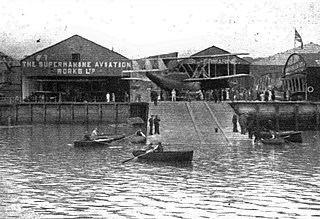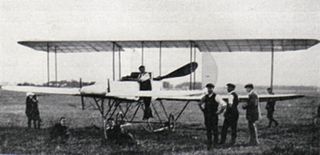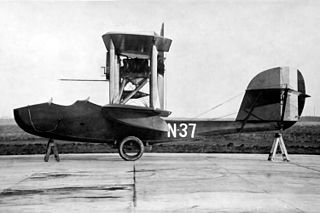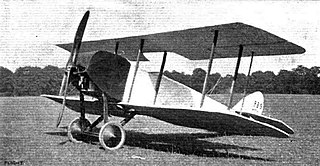
Supermarine was a British aircraft manufacturer that is most famous for producing the Spitfire fighter plane during World War II as well as a range of seaplanes and flying boats, and a series of jet-powered fighter aircraft after World War II. The company had successes in the Schneider Trophy for seaplanes, with three wins in a row of 1927, 1929 and 1931.

The AD Flying Boat was designed by the British Admiralty's Air Department to serve as a patrol aircraft that could operate in conjunction with Royal Navy warships. Intended for use during the First World War, production of the aircraft was terminated as the end of the war came into sight, and the type saw little operational use. A number were repurchased after the end of the war by Supermarine Aviation and rebuilt as civil transports, becoming known as the Supermarine Channel.

The Bristol Scout was a single-seat rotary-engined biplane originally designed as a racing aircraft. Like similar fast, light aircraft of the period it was used by the RNAS and the RFC as a "scout", or fast reconnaissance type. It was one of the first single-seaters to be used as a fighter aircraft, although it was not possible to fit it with an effective forward-firing armament until the first British-designed gun synchronizers became available later in 1916, by which time the Scout was obsolescent. Single-seat fighters continued to be called "scouts" in British usage into the early 1920s.

The Supermarine Seagull was a amphibian biplane flying boat designed and produced by the British aircraft manufacturer Supermarine. It was developed from the experimental Supermarine Seal II.

The S.E.1 was an experimental aircraft built at the Army Balloon Factory at Farnborough in 1911. Its place in aviation history is mainly that it was the first in the series of Royal Aircraft Factory designs - several of which played an important role in World War I.
The Pemberton-Billing P.B.25 was a First World War British single-seat scout aircraft built by Pemberton-Billing Limited, later Supermarine Aviation Works Limited.

The Supermarine S.5 was a 1920s British single-engined single-seat racing seaplane built by Supermarine. Designed specifically for the Schneider Trophy competition, the S.5 was the progenitor of a line of racing aircraft that ultimately led to the Supermarine Spitfire.

The Supermarine Sea King was a British single-seat amphibious biplane fighter designed by Supermarine in 1919. Developed from the Supermarine Baby and the Supermarine Sea Lion I, the Sea King was a single seater biplane powered by a pusher 160 horsepower (120 kW) Beardmore engine. It first flew in early 1920 and was exhibited by Supermarine at the 1920 Olympia Show in London. The company released drawings of the aircraft's design prior to the show; what it exhibited was probably a modified Supermarine Baby.

The Supermarine Baby was a World War I fighter aircraft that was the earliest example of single-seat flying boat fighter to be built in the United Kingdom. It was designed by Supermarine to meet a 1917 Navy Board specification which stipulated the aircraft have a speed of 95 knots, a ceiling of 20,000 feet (6,100 m), and be capable of being launched from ships at sea. When it first flew in February 1918 it was the smallest and fastest flying boat then in existence.
The Supermarine Sea Urchin was an unbuilt British racing biplane flying boat designed by the Supermarine Aviation Works to compete in the 1924 Schneider Trophy. It was to be a single seat biplane, powered by a Rolls-Royce Condor V-12 water-cooled engine buried in the fuselage, driving a pusher propeller mounted on the upper wing via geared shafts. It was abandoned without being built owing to problems with the engine and the transmission required to drive the propeller.

The Supermarine Seal II was a British flying boat developed by Supermarine after it secured a British Air Ministry order for a prototype three-seater fleet spotter amphibian. The prototype, which had to be capable of landing on Royal Air Force (RAF) aircraft carriers, was designed by Supermarine's R.J. Mitchell, who incorporated suggestions made after the Supermarine Commercial Amphibian achieved second place after it was entered for an Air Ministry competition in 1920.

The Norman Thompson N.1B was a prototype British flying boat fighter aircraft of the First World War. A two-seat single-engined pusher biplane, a single example was built in 1917, but no production followed.

The Handley Page Type E was a two-seat, single-engined monoplane intended as a demonstrator. Though only one was built, it flew successfully from 1912 to 1914, carrying several hundred passengers and flying several thousand miles.
The Sopwith Three-seater was a British aircraft designed and built prior to the start of the First World War. One of the first aircraft built by the Sopwith Aviation Company, it was operated by both the Royal Naval Air Service (RNAS) and the Royal Flying Corps (RFC), being used briefly over Belgium by the RNAS following the start of the War.

The Sopwith Bat Boats were British flying boats designed and built from 1912 to 1914. A single-engined pusher biplane, the Bat Boat was the first successful flying boat and amphibious aircraft built in the United Kingdom, with examples used by the Royal Navy and by Greece and Germany.

The Dunne D.8 of 1912 was a tailless swept wing biplane, designed by J. W. Dunne to have inherent stability. One example was supplied to RAE Farnborough. License-built Burgess-Dunne models were used by the US Signal Corps and United States Navy and the short-lived Canadian Aviation Corps. It was the latter's first and only warplane.

The White & Thompson No. 1 Seaplane was the first British built twin-engined biplane flying boat, assembled just prior to the outbreak of the First World War to compete in an air-race around the UK. It was unsuccessful, only the single prototype being built.

The Pemberton-Billing P.B.9 was a First World War British single-seat open cockpit equal span biplane scout aircraft built by Pemberton-Billing Limited, which later became the Supermarine Aviation Works. Only one P.B.9 was built.
The London and Provincial Fuselage Biplane was a British single-engined two-seat training aircraft of the First World War. While the aircraft demonstrated excellent manoeuvrability, only a single example was built.

The Hillson Bi-mono was a British experimental aircraft of the 1940s. It was designed to test the idea of "slip-wings", where the aircraft could take off as a biplane, jettison the upper, disposable wing, and continue flying as a monoplane. A single example was built, which successfully demonstrated jettisoning of the slip wing in flight.
















